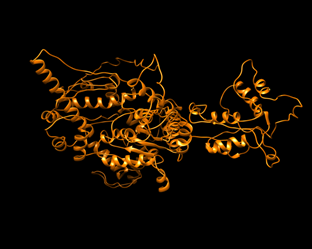A Comprehensive In Silico Analysis of Deleterious SNPs of Paraplegin Protein Associated with Hereditary Spastic Paraplegia through Mitochondrial Dysfunction
Abstract
 Abstract Views: 274
Abstract Views: 274
Hereditary spastic paraplegia (HSP) is a heterogenous neurological disorder primarily associated with progressive spasticity. Paraplegin is a mitochondrial protein and mutations in this protein can lead to HSP. In this study, in silico analysis was carried out to identify the pathogenic variants of SPG7 (paraplegin protein). To find novel pathogenic mutations, missense and splicing variants were collected from gnomAD database and passed through a detailed and stringent analysis with the help of a variety of bioinformatic tools. The list of mutations was examined and compared in ClinVar. Altogether, 14 missense mutations and 18 splicing mutations were obtained and these mutations were predicted to have the potential of disrupting the normal structural and functional properties of paraplegin protein.
Copyright(c) The Authors
Downloads
References
. Depienne C, Stevanin G, Brice A, Durr A. Hereditary spastic paraplegias: an update. Curr Opin Neurol. 2007;20(6): 674–680.
. Giudice TL, Lombardi F, Santorelli FM, Kawarai T, Orlacchio A. Hereditary spastic paraplegia: clinical-genetic characteristics and evolving molecular mechanisms. Exp Neurol. 2014;261: 518–539.
. Shribman S, Reid E, Crosby AH, Houlden H, Warner TT. Hereditary spastic paraplegia: from diagnosis to emerging therapeutic approaches. Lancet Neurol. 2019;18(12): 1136–1146.
. Wali G, Kumar KR, Liyanage E, Davis RL, Mackay A-S, Sue CM. Mitochondrial function in hereditary spastic paraplegia: deficits in SPG7 but not SPAST patient-derived stem cells [published online ahead of print August 20, 2020]. Front Neurosci. https://www.frontiersin.org/articles/10.3389/fnins.2020.00820/full
. Zhang X, Zhang L, Wu Y, et al. Identification of novel compound heterozygous SPG7 mutations-related hereditary spastic paraplegia in a Chinese family: a case report. BMC Neurol. 2018;18(1): 196.
. Koppen M, Metodiev MD, Casari G, Rugarli EI, Langer T. Variable and tissue-specific subunit composition of mitochondrial m-AAA protease complexes linked to hereditary spastic paraplegia. Mol Cell Biol. 2007;27(2): 758–767.
. Flanagan SE, Patch A-M, Ellard S. Using SIFT and PolyPhen to predict loss-of-function and gain-of-function mutations. Genet Test Mol Biomarkers. 2010;14(4): 533–537.
. Srinivasan E, Natarajan N, Rajasekaran R. TTRMDB: a database for structural and functional analysis on the impact of SNPs over transthyretin (TTR) using bioinformatic tools [published online ahead of print May 25, 2020]. Comput Biol Chem. 2020;87: 107290.
. Karczewski K, Francioli L. The genome aggregation database (gnomAD). MacArthur Lab Web site. https://macarthurlab.org/2017/02/27/the-genome-aggregation-database-gnomad/ Updated February 27, 2017.
. Rentzsch P, Witten D, Cooper GM, Shendure J, Kircher M. CADD: predicting the deleteriousness of variants throughout the human genome. Nucleic Acids Res. 2019;47 (D1): D886–D894.
. Capriotti E, Fariselli P. PhD-SNPg: a webserver and lightweight tool for scoring single nucleotide variants. Nucleic Acids Res. 2017;45(W1): W247–W252.
. Bendl J, Musil M, Štourač J, Zendulka J, Damborský J, Brezovský J. Predict SNP2: a unified platform for accurately evaluating SNP effects by exploiting the different characteristics of variants in distinct genomic regions. PLoS Comput Biol. 2016;12(5): e1004962.
. Salgado D, Desvignes JP, Rai G, et al. UMD-predictor: a high‐throughput sequencing compliant system for pathogenicity prediction of any human cDNA substitution. Hum Mutat. 2016;37(5): 439–446.
. Capriotti E, Calabrese R, Fariselli P, Martelli PL, Altman RB, Casadio R. WS-SNPs & GO: a web server for predicting the deleterious effect of human protein variants using functional annotation. BMC Genomics. 2013;14(3): S6.
. Choi Y, Chan AP. PROVEAN web server: a tool to predict the functional effect of amino acid substitutions and indels. BMC Bioinf. 2015;31(16): 2745–2747.
. Landrum MJ, Lee JM, Benson M, et al. ClinVar: improving access to variant interpretations and supporting evidence. Nucleic Acids Res. 2017;46(D1): D1062–D1067.
. Yang J, Zhang, Y. Protein structure and function prediction using I-TASSER. Curr Protoc Bioinf. 2015;52(1): 5.8.1–5.8.15. https://pubmed.ncbi.nlm.nih.gov/26678386/
. Chen CW, Lin J, Chu YW. iStable: off-the-shelf predictor integration for predicting protein stability changes. BMC Bioinf. 2013;14: S5.
. Pettersen EF, Goddard TD, Huang CC, et al. UCSF Chimera—a visualization system for exploratory research and analysis. J Comput Chem. 2004;25(13): 1605–1612.
. Yang Z, Lasker K, Schneidman D-D, et al. UCSF Chimera, MODELLER, and IMP: an integrated modeling system. J Struct Biol. 2012;179(3): 269–278.
. Finsterer J, Löscher W, Quasthoff S, Wanschitz J, Auer M-G, Stevanin G. Hereditary spastic paraplegias with autosomal dominant, recessive, X-linked, or maternal trait of inheritance. J Neurol Sci. 2012;318(1-2): 1–18.
. Klebe S, Stevanin G, Depienne C. Clinical and genetic heterogeneity in hereditary spastic paraplegias: from SPG1 to SPG72 and still counting. Rev Neurol. 2015;171(6-7): 505–530.
. Campuzano O, Allegue C, Fernandez A, Iglesias A, Brugada R. Determining the pathogenicity of genetic variants associated with cardiac channelopathies. Sci Rep. 2015;5: 7953.
. Young DL, Fields S. The role of functional data in interpreting the effects of genetic variation. Mol Biol Cell. 2015;26(22): 3904–3908.
. Scheiner S, Kar T, Pattanayak J. Comparison of various types of hydrogen bonds involving aromatic amino acids. J Am Chem Soc. 2002;124(44): 13257–13264.
. Kyte J, Doolittle RF. A simple method for displaying the hydropathic character of a protein. J Mol Biol. 1982;157(1): 105–132.
. Anna A, Monika G. Splicing mutations in human genetic disorders: examples, detection, and confirmation. J Appl Genet. 2018;59(3): 253–268.

Copyright (c) 2020 Ammara Akhtar, Sobia Nazir Choudhry, Rana Muhammad Mateen, Mureed Hussain

This work is licensed under a Creative Commons Attribution 4.0 International License.
BSR follows an open-access publishing policy and full text of all published articles is available free, immediately upon publication of an issue. The journal’s contents are published and distributed under the terms of the Creative Commons Attribution 4.0 International (CC-BY 4.0) license. Thus, the work submitted to the journal implies that it is original, unpublished work of the authors (neither published previously nor accepted/under consideration for publication elsewhere). On acceptance of a manuscript for publication, a corresponding author on the behalf of all co-authors of the manuscript will sign and submit a completed the Copyright and Author Consent Form.









